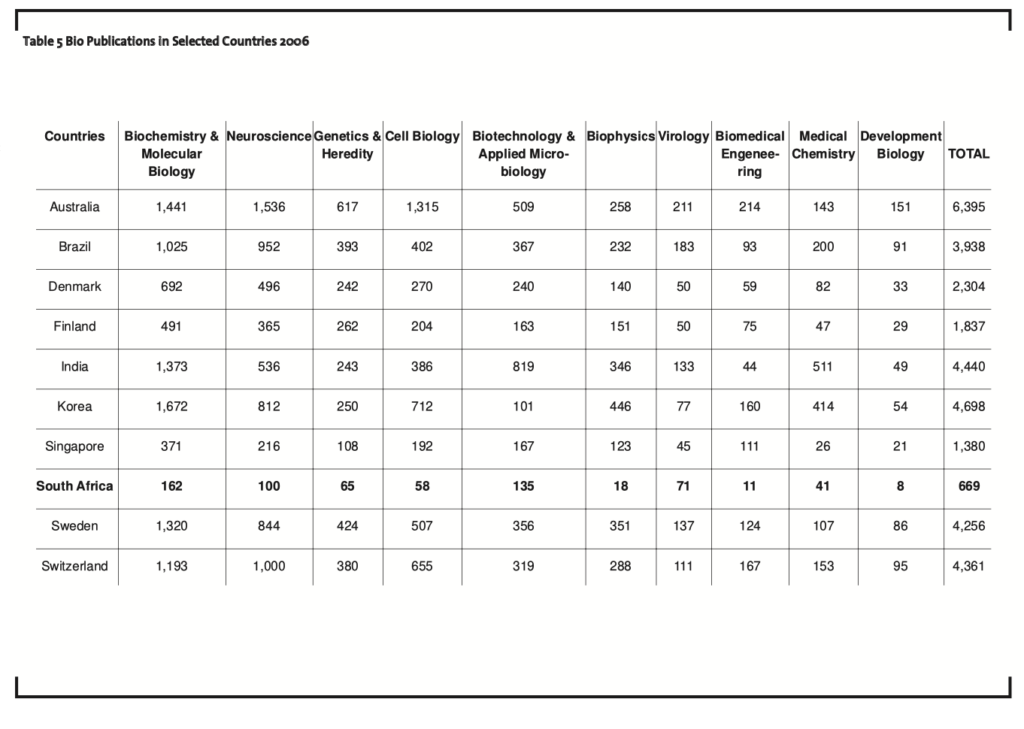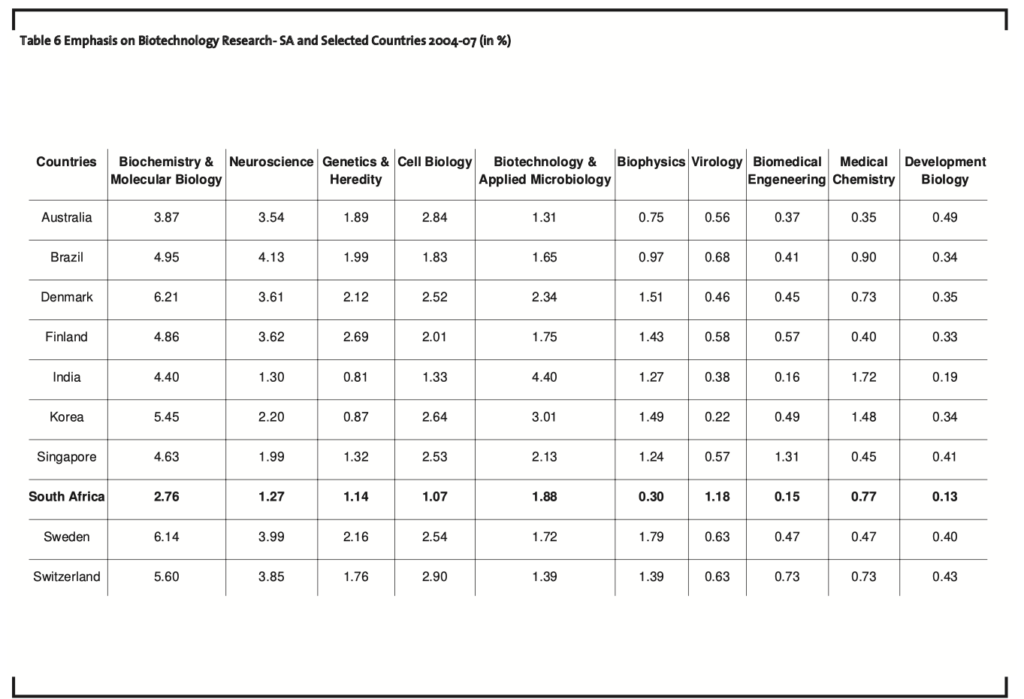Biotechnology Research in South Africa: A Benchmarking Exercise
Biotechnology has been identified as a priority area for the national innovation system in South Africa. Since 2003 new structures have been established in the country in order to enhance biotechnology research and innovation in accordance with the “National Biotechnology Strategy”. Recently and for the first time in the country’s science policy history, the Department of Science and Technology published the “Ten Year Plan 2008-2018” which sets quantitative objectives for the national system. The effort of this article is to benchmark the country’s research related to biotechnology in order to provide the foundations for the monitoring of the evolution of the field and the accomplishment of the broad objectives set by the Department of Science and Technology. The international comparisons identify a number of management challenges and policy concerns and the extent of efforts required so that the South African biotechnology innovation system meets the objectives set by the Government.
Introduction
Biotechnology is internationally believed to be the next revolutionary scientific endeavour in the history of humanity. Researchers suggest that the same way that steam power and the railway and more recently information and communication technologies have revolutionized society, biotechnology will change the way we live and we think about living organisms and society (Freeman and Soete, 1997).
Biotechnology as a research domain opens up the way for new applications in healthcare, agriculture, food production, environmental protection, development of materials and chemicals, and new scientific discoveries. The new technologies regenerate old industries and create new businesses offering skilled jobs that sustain knowledge-based economies and produce economic growth.
The economic prospects led a number of countries to develop relevant policies and provide incentives for the promotion of research, development and innovation and as a consequence a number of studies have been undertaken monitoring and assessing the performance of biotechnology in those countries (European Commission, 2003; Reiss, and Dominguez-Lacasa, 2005).
The South African government supports biotechnology and encourages home grown research. A recent report identifies that South Africa exerts leadership and provides the example for the adoption and acceptance of biotech crops in the African continent and globally (James, 2007). South Africa is classified as the only country in the African continent and one of the 14 biotech mega-countries in the world. Countries are classified as biotech mega-countries when they grow 50,000 hectares, or more, of biotech crop. Furthermore, a multi-criteria survey identified that an approving climate of opinion prevails towards biotechnology in the country (Pouris, 2003b).
Moreover the recently published “Ten Year Plan” of the Department of Science and Technology sets the vision that South Africa should be “among the global top ten nations in the world in terms of the pharmaceutical, nutraceutical, flavour, fragrance and bio-pesticide industries” by 2018 (DST, 2007).
The purpose of this study is to identify the state of biotechnology research in the country in quantitative terms (specific and measurable objectives required by the management by objectives set by the government) in order to inform relevant policy in South Africa.
More specifically the effort is to identify the research performance of the country in biotechnology research over time and in comparison with a number of target countries. The results of the investigation can constitute the benchmarks for monitoring of the evolution of the research in the field and the accomplishment of the objectives set by the Department of Science and Technology.
Methodological Issues
Any analysis in the field of biotechnology faces a number of methodological hurdles. The challenges arise from the character of biotechnology. Biotechnology is used for producing existing products in new ways, identifying new product opportunities (as in drug discovery), and for producing new products that could not be commercially produced before (as with many large molecule therapeutics and some genetically modified plant varieties). The wide range of uses for biotechnology means that it is a generic technology with applications in many different economic sectors.
The OECD has developed both a single definition of biotechnology and a list-based definition of different types of biotechnology (OECD, 2006). The single definition defines biotechnology as “the application of science and technology to living organisms, as well as parts, products and models thereof, to alter living or nonliving materials for the production of knowledge, goods and services.”
The OECD list-based definition of biotechno- logy includes a number of techniques such as genomics, sequencing of proteins and peptides, cell and tissue culture.
The above definitions underline the fact that biotechnology is a particularly research intensive domain. The European Commission states (European Commision, 2002):
“The life sciences revolution was born in, and is fed and nurtured by, research. Public research laboratories and institutions of higher education are at the core of the science base interacting also with enterprise based research and that of other private bodies. The success of any knowledge-based economy rests upon the generation, diffusion and application of new knowledge. Investments in research and development, education and training and new managerial approaches are therefore of key importance in meeting the challenges posed by life sciences and biotechnology.”
The high research intensity of the sector justifies our emphasis on the use of scientometrics techniques as a tool for evaluation purposes. Countries with weak biotechnology research capacity and hence weak publication profiles will undoubtedly be weak in the innovation spectrum of the biotechnology sector.
The ISI databases (Science Citation Index Expanded, Social Sciences Citation Index and Arts and Humanities Citation Index) were identified as the most appropriate for the objectives of the investigation. The ISI databases are used extensively for similar studies in biotechnology (DST, 2007) ,and other scientific disciplines (Braun et al., 1997).
The combined databases cover comprehensively the most prestigious journals in the world in all fields of research endeavours and constitute a unique information platform for the objectives of this effort.
Furthermore, in South Africa universities receive subsidy from the Department of Education according to the number of publications in ISI journals (and in an additional departmental list) and universities provide incentives to their researchers to publish in ISI journals. Consequently those journals cover adequately the South African research effort.
The databases classify the articles to different scientific disciplines according to the character of the journals in which they appear. Following the example of VINNOVA (VINNOVA, 2003) the following scientific disciplines were considered as constituting the biotechnology literature: Biochemistry and Molecular Biology; Microbiology; Biotechnology and Applied Microbiology; Genetics and Heredity; Cell Biology; Virology; Neurosciences; Chemistry Medicinal; Biophysics; Engineering Biomedical and Developmental Biology. While the associations and linkages of the above disciplines with biotechnology are well known, it is worth clarifying the presence of neurosci- ences and developmental biology in the set. Modern molecular biology and cell biology methods have been used in neurobiological research in association with older methods for the past two decades. More recently, however, neurosciences are interlinked with novel technologies such as genomics and differential gene expression methods. Similarly, developmental biology has emerged as a promising new field. The focus of developmental biology is the identification of the mechanisms underlying embryonic development of tissues and organs and specifically genes which are involved in promoting differentiation and growth of different tissue types and in controlling organ development.
The developed database was analyzed in order to identify South African researchers publishing biotechnology related research. South African authors have been identified on the basis of their addresses in the published articles.
The results of the analysis are compared with the performance of a number of countries which are recognized as leaders in the field of biotechnology. The choice of the comparator countries is made in order to provide an indication of the current state of the country’s research vis-a-vis the vision that has been set by the country’s Government. (The Scandinavian countries, Singapore and Switzerland are among the leading countries in the world in the field of biotechnology and South Africans often use Australia and Brazil for comparative purposes).
Biotechnology and Related Research in South Africa
Analysis of the ISI databases identified 6,006 articles in biotechnology disciplines with at least one South African author for the period 1995-2006. “Biochemistry and molecular biology” is the most prolific discipline contributing 1,601 publications during the period (see table 1). Micro-biology and biotechnology & applied micro-biology follow with 1,049 and 1,009 publications respectively. The column total shows the actual number of South African articles and it is less than the sum of the horizontal cells in the table. This is happening because articles may be classified to more than one scientific discipline.
Table 2 shows the growth in the number of publications in the various biotechnology disciplines from the beginning of the period (1995- 1998) to the end of the period (2003-2006). Neurosciences exhibit the largest growth (265 %) albeit from a small basis (20 publications per year). Virology and developmental biology follow from similarly small initial bases. The growth of the total number of biotechnology articles over the period was 64.5 %. During the same period the total number of publications from South Africa increased from 18,206 (1995-1998) to 22,473 (2003-2006) – an increase of 23 %. It is noticeable that the relative prolific disciplines (e.g. microbiology and biotechnology & applied microbiology) will need more than 10 years in order to double their size.
Table 3 shows the relative emphasis placed in the most prolific biotechnology disciplines in comparison to selected disciplines in South Africa. The emphasis is estimated as the ratios of disciplinary publications to the total number of publications from the country during the most recent period 2004-2007 (August) and during the period 1995-2006.
The table shows that environment, plant and animal research attracts substantially more attention than the biotechnology related disciplines. These findings reconfirm our previous finding (Pouris, 2003a) that “the active South African disciplines (that is, those with publication rates above the national average of 0.5 %) are those involving its natural wealth, that is, ecology/environment, geosciences, plant and animal sciences, and space science (astronomy)”. Comparison of the research emphasis in the two periods indicates that the biotechnology related disciplines (with the exception of neurosciences) had only marginal improvements. It is worth mentioning the substantial drop in emphasis in medicine, general and internal.
Figure 1 shows the extent of collaboration of South African researchers in the biotechnology related disciplines and at the national level (as it is estimated by the ratio of collaborative articles to total number of local articles). Collaboration in biotechnology research follows the broad national patterns with USA being the main collaborating partner followed by England and Germany.
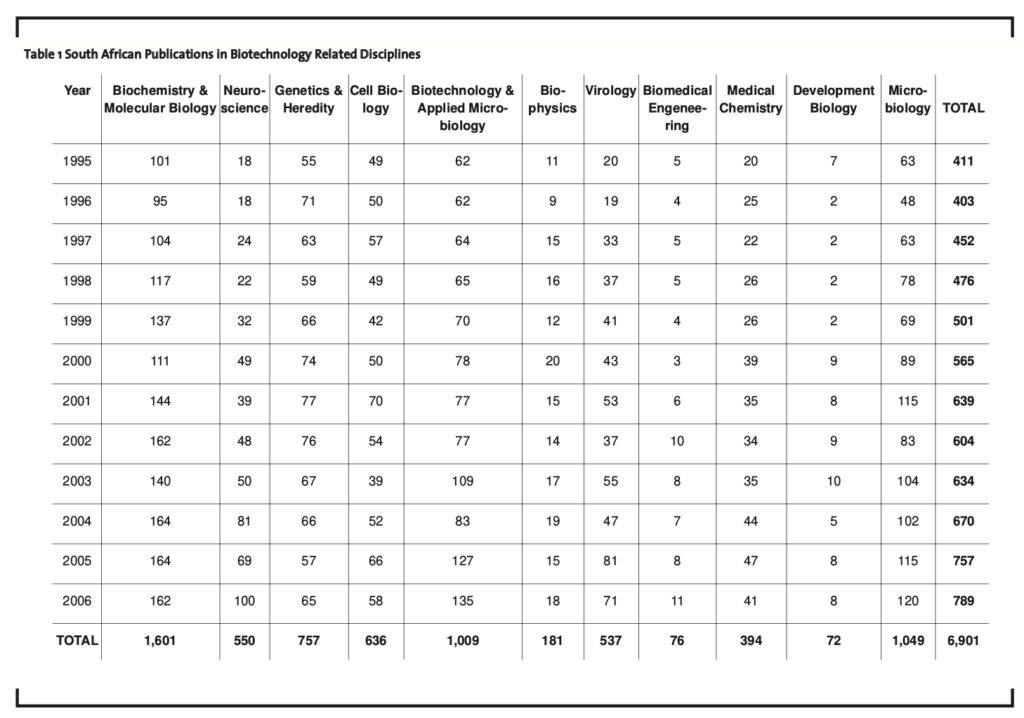
It should be noted that collaboration in biotech- nology related disciplines is substantially higher than the national average. The second issue that we examine is the identification of the sources of biotechnology research in the country. Table 4 shows the main South African producers of biotechnology related research.
The University of Cape Town with 1,329 publications (22 % of the total) appears to have been the major contributor of biotechnology research in the country since 1995. The universities of Stellenbosch and Witwatersrand follow having contributed 17.5 % and 16 % of the total number of publications respectively. Absent from this list
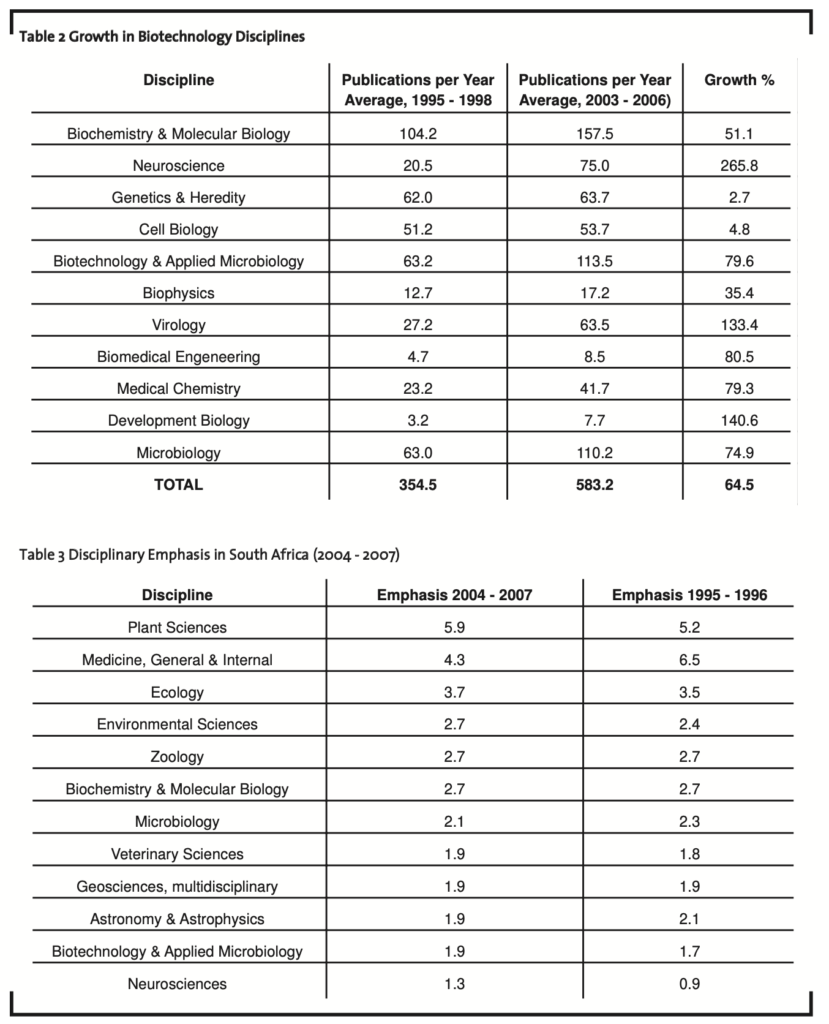
are the country’s research councils (i.e. Medical Research Council, Agricultural Research Council, CSIR and MINTEK) which contribute less thanthree percent of the country’s research publications in the field each. Similarly absent are studies from industrial establishments in the country.
The two companies with certain presence are SAPPI with 17 publications over the period and the South African Breweries with 14 publications. Table 4 also shows the biotechnology emphasis within the various institutions. Biotechnology emphasis is estimated as the ratio of the number of biotechnology related articles to the total number of articles produced by the researchers of the institution. It should be expected that in institutions with high emphasis in biotechnology the relevant researchers have more power to influence university decisions than in institutions with low relative emphasis. The University of Stellenbosch is identified as the most biotechnology-intensive institution in the country with 16 % of its publications being related to biotechnology research.
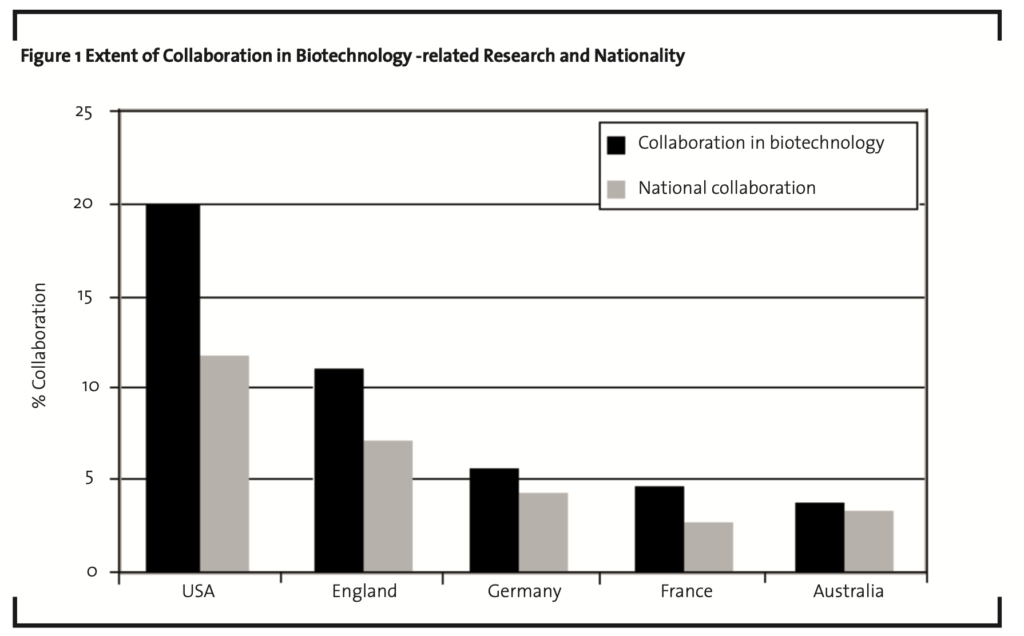
The third issue we investigate is related to South Africa’s performance in biotechnology research vis-à-vis the performance of a number of other countries. Table 5 (see appendix 1) shows the number of publications from a number of countries in the disciplines related to biotechnology during 2006. South Africa produces substantially smaller numbers of publications than the other countries – even though there are countries with substantially smaller populations (e.g. Singapore and Fin- land with populations around 5 million). South Africa compares favourably with Singapore only in the fields of microbiology and virology. South Africa needs to increase its output by factors ranging from three to five if it wishes to compare favourably with those countries.
The suggested increase can be the result of a redirection/redeployment of human resources from other scientific disciplines or the result of an enlargement of the whole of the scientific system. Table 6 (see appendix 2) shows the research emphasis (number of biotechnology related articles as a percentage of the total number of articles from the country) placed on the various biotechnology related scientific disciplines in South Africa and the comparator countries. In comparison to other countries South Africa does not place enough research emphasis in biochemistry and molecular biology, cell biology, biophysics and developmental biology. In those disciplines South Africa should double its emphasis in order to be within the comparator counties’ norms. On the other hand South Africa places a comparative over-emphasis on virology and it is within the standards of the comparator countries in biotechnology & applied microbiology and microbiology.
Conclusions
This article sets the objective to identify the state and trends of biotechnology research in South Africa in order to provide the context in which the government has set the objective of South Africa being among the global top ten nations in the world in the field by the year 2018.
Academic research, as is manifested in publications, is of particular importance for the field of biotechnology as empirical studies supported by the European Commission show that “policies to create and sustain the knowledge base are crucial for commercialisation but the reverse is not true” (European Commision, 2003; Reiss; Dominguez-Lacara, 2005). Our findings are as follows:
- South Africa has a growing biotechnology research system. During the most recent ten year period there was an average growth in biotechnology related publications of 64 % while the growth in the country’s publications has been 25 %.
- In comparison to leading countries in biotechnology research South Africa needs to increase its research publications by a factor of three in order to produce a similar volume of knowledge in the field.
- The South African research system over-emphasises the macro-aspects of plant sciences, animal sciences and environmental related sciences in comparison to biotechnology related disciplines.
- Three universities – University of Cape Town, University of Stellenbosch and University of Witwatersrand – have produced more than 50% of the country’s publications during the last ten years. An important finding is that the country’s research councils (i.e. CSIR, MRC, MINTEC, ARC etc.) produce a minimal number of publications in the field of biotechnology.
- South Africa pays half as much emphasis on biotechnology related disciplines as the comparator countries. Exceptions are the disciplines of biotechnology and applied microbiology and of microbiology which are within the standards set by the comparator countries.
The above findings have a number of policy implications. The South African government will have to establish a number of policy measures in order to accelerate the growth of knowledge production in the field of biotechnology. This can be achieved firstly by re-directing researchers to the fields of biotechnology, for example, through different value bursaries and research grants, and secondly by expanding the research system. The above-mentioned analysis indicates that the biotechnology research system can be doubled in size without having to expand the total research system. After that doubling, however, the country’s research emphasis will be within the comparator countries’ norms and further expansion may be achieved through growth of the total research system. In this context, it should be emphasized that South Africa follows a pluralistic approach in the management of its national research system. There is no differentiation in the research support of various disciplines, policy instruments are introduced without assessing their impact on other areas of importance, government departments follow their own policies – sometimes neutralizing other departments’ policies – and similar. Redirecting the university research system towards biotechnology related disciplines will require a fresh thinking and the development of powerful policy instruments by the Department of Science and Technology.
It is interesting to discuss the differences which arise when the relevant size of countries (population or GDP) is taken into account. For example, comparison of the absolute number of publications produced annually indicates that South Africa needs to increase its relevant production rate by a factor of three in order to be comparable with the other leading countries. However, when we estimate the required increase for comparability taking into account the population size of the various countries (number of publications per capita) we find that South Africa requires a growth by a factor of ten. In this context the absolute number of publications is indicative of the size of the research system that may be required in order to have a viable and effective biotechnology research system. If the successful countries can support a biotechnology innovation system with a particular size biotechnology research system, other countries could emulate those countries with similar size bio-research systems. A caveat that should be mentioned is the extent of concentration of the bio-research system. The performance of the innovation system, under ceteris paribus conditions, may be different in a country with five million people than in one with fifty million people, even though both may have the same size research systems. The difference will be the effect of the dispersion of research in the larger country. Successful research and innovation require a certain critical mass and proximity which may not be always available in relatively larger countries. It will be important to identify the critical mass required, say within a particular institution, in order to have a successful biotechnology group.
The finding that the country’s research councils (government contract research organisations) make a minimal contribution in terms of publications in the field of biotechnology is also of policy importance. Research councils in South Africa (functioning as contract research organisations) boast their involvement in the field and their successes which range from DNA fingerprinting of plant cultivars to increase by 188 % of the size of the knob of ginger and from the development of pearl millet resistant to downy mildew to the development of BACOXTM gold bioleaching technology. Their absence from the publication arena, however, may be interpreted as meaning that their “researchers” are not in the research front. If this assertion is correct, research councils in South Africa run the danger that they will eventually become uncompetitive internationally with adverse consequences for their technology transfer activities and their contribution to the country’s research system.
In concluding it should be emphasized that the management by objectives (setting targets) that has been introduced in South Africa has a number of advantages. Probably the most important benefits are the inducement of the monitoring and benchmarking of the national system of innovation and the governmental focus on particular disciplines and technologies. The last issue has been identified by OECD as one of the major weakness in science and technology policy in South Africa.
References
Braun, T.; Schubert, S.; Zsindely, S. (1997): Nanoscience and nanotechnology on the balance, Scientometrics, 38 (2), pp. 321–325.
Dalpe, R. (2002): Bibliometric analysis of biotechnology, Scien- tometrics, 55, pp. 189–213.
DST (2007): Innovation Towards a Knowledge-based Econo- my –Ten-year Plan for South Africa 2008-2018. Depart- ment of Science and Technology, Pretoria.
European Commission (2002): Life Sciences and Biotechno- logy – A Strategy for Europe. Communication from the Commission to the European Parliament, the Council, the Economic and Social Committee and the Commit- tee of the Regions Com 27 Luxembourg.
European Commission (2003): Efficiency of Innovation Poli- cies in High Technology Sectors in Europe (EPOHITE), Final Report from STRATA Accompanying Measures, EUR 20904.
Freeman, C.; Soete, L. (1997): The Economics of Industrial Innovation. MIT Press, Cambridge, MA.
James, C. (2007): Global Status of Commercialised Biotech/GM Crops: 2006. International Service for the Acquisition of Agri-Biotech Applications, ISAAA, accessed at URL: http://www.isaaa.org, March 2007.
Molatudi M.; Pouris A., (2006): Assessing the Knowledge Base for Biotechnology in South Africa: A Bibliometric Analysis of South African Microbiology and Molecular Biology and Genetics Research. Scientometrics, 68(1), pp. 97-108.
OECD (2006): OECD Framework for Biotechnology Statistics. Organisation for Economic Cooperation and Development, Paris.
Pouris, A. (2003a): South Africa’s Research Publication Record: the Last Ten Years. South African Journal of Science, 99, pp. 425–428.
Pouris, A. (2003b): Assessing Public Support for Biotechnology in South Africa. South African Journal of Science, 99, pp. 513-516.
Reiss, T.; Dominguez-Lacasa, I. (2005): Indicators for benchmarking biotechnology innovation policies. Fraunhofer ISI, Karlsruhe.
VINNOVA (2003): Swedish Biotechnology- Scientific Publications, Patenting and Industrial Development. Swedish Agency for Innovation Systems, VA2003:2.
Appendix
